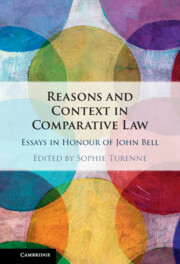Book contents
- Reasons and Context in Comparative Law
- Reasons and Context in Comparative Law
- Copyright page
- Contents
- Contributors
- Foreword
- Preface: John Bell
- Acknowledgements
- 1 Introduction
- 2 What Can Law Schools Offer Other Disciplines?
- 3 Examining Vicarious Liability Comparatively
- 4 What’s in a Name?
- 5 ‘An Art Obscured with Difficult Cases’
- 6 Observations on the Reform of the French Law on Contractual Interpretation
- 7 Assessing (Divergent) Legal Development
- 8 Roundabout Law
- 9 A Comparative Reflection on Chilean Economic Torts
- 10 Judicial Identity Crises
- 11 Researching Judicial Cultures in the European Union
- John Bell’s Principal Publications
- Index
3 - Examining Vicarious Liability Comparatively
A Risky Business?
Published online by Cambridge University Press: 27 April 2023
- Reasons and Context in Comparative Law
- Reasons and Context in Comparative Law
- Copyright page
- Contents
- Contributors
- Foreword
- Preface: John Bell
- Acknowledgements
- 1 Introduction
- 2 What Can Law Schools Offer Other Disciplines?
- 3 Examining Vicarious Liability Comparatively
- 4 What’s in a Name?
- 5 ‘An Art Obscured with Difficult Cases’
- 6 Observations on the Reform of the French Law on Contractual Interpretation
- 7 Assessing (Divergent) Legal Development
- 8 Roundabout Law
- 9 A Comparative Reflection on Chilean Economic Torts
- 10 Judicial Identity Crises
- 11 Researching Judicial Cultures in the European Union
- John Bell’s Principal Publications
- Index
Summary
This chapter examines vicarious liability, that is, liability in tort for the tortious acts of others, and the insights that may be gained from a comparative law perspective. John Bell’s work on vicarious liability was cited by the UK Supreme Court in Cox v. Ministry of Justice [2016] UKSC 10, in support of its view that vicarious liability could be justified where the defendants had, in the exercise of their mission or enterprise, placed the tortfeasor in a position where the commission of the tort was an inherent risk of the activities assigned to them. This chapter examines comparatively the role ’risk’ plays in contemporary vicarious liability discourse. While civil law systems such as France have long embraced notions of risk, the common law courts have been slower to respond. Since 2000, however, UK and Canadian case law has indicated a willingness to move in this direction. In contrast, the Australian courts continue to resist the lure of risk- based analysis as an explanation and justification for the imposition of vicarious liability. Is relying on risk as a justification a ’risky business’ or inevitable if one wishes to expand this doctrine to meet the needs of meritorious litigants?
Keywords
Information
- Type
- Chapter
- Information
- Reasons and Context in Comparative LawEssays in Honour of John Bell, pp. 38 - 64Publisher: Cambridge University PressPrint publication year: 2023
